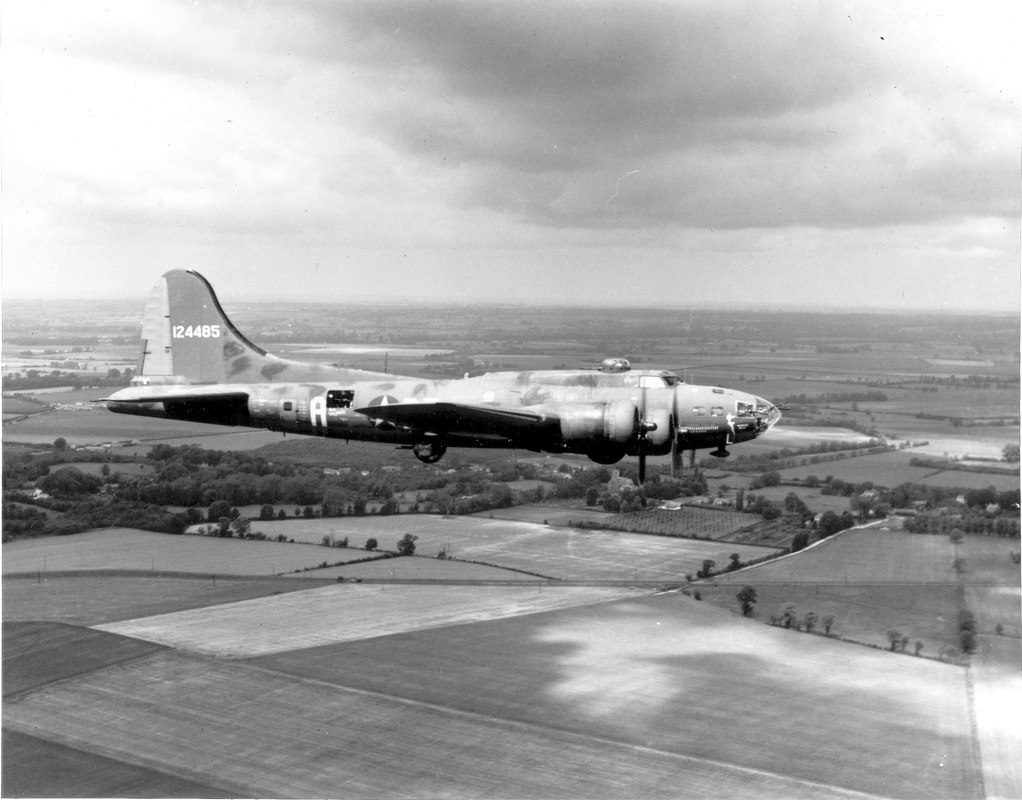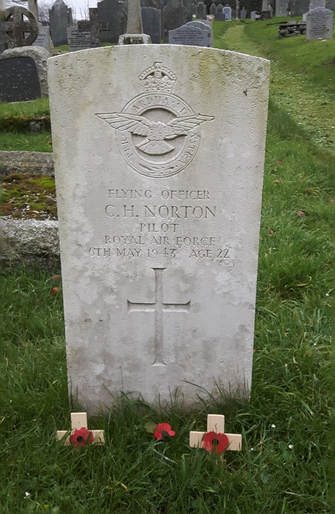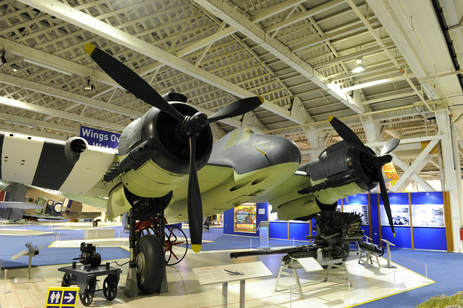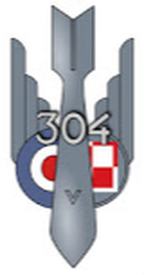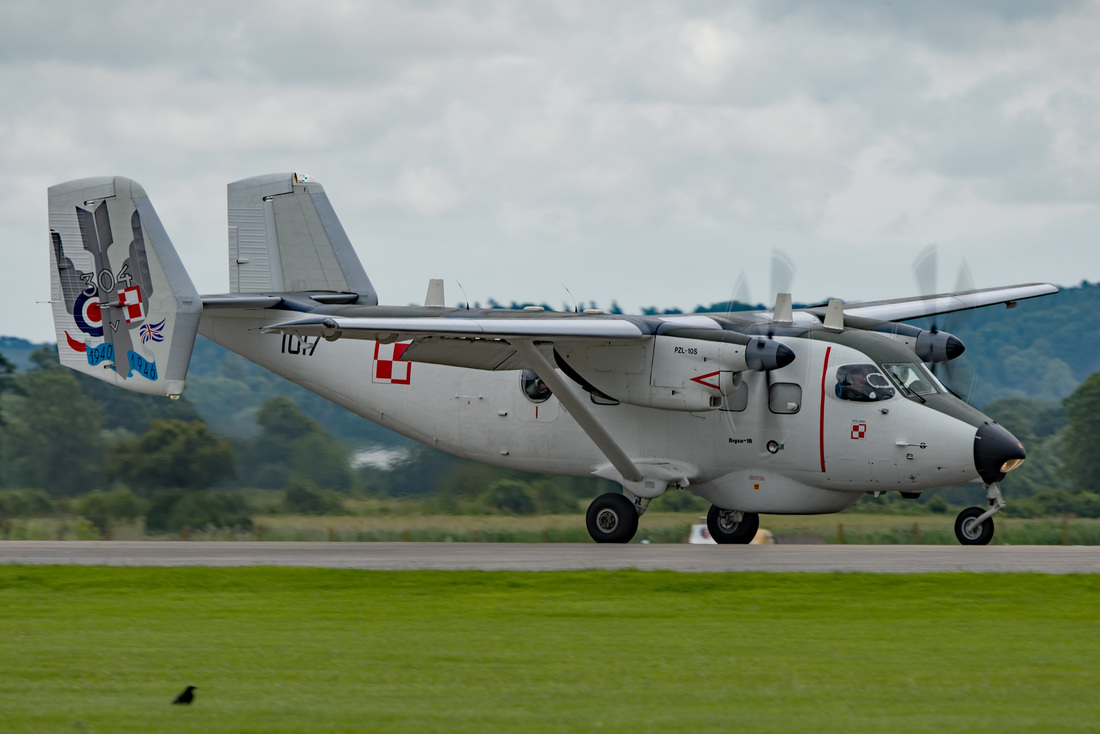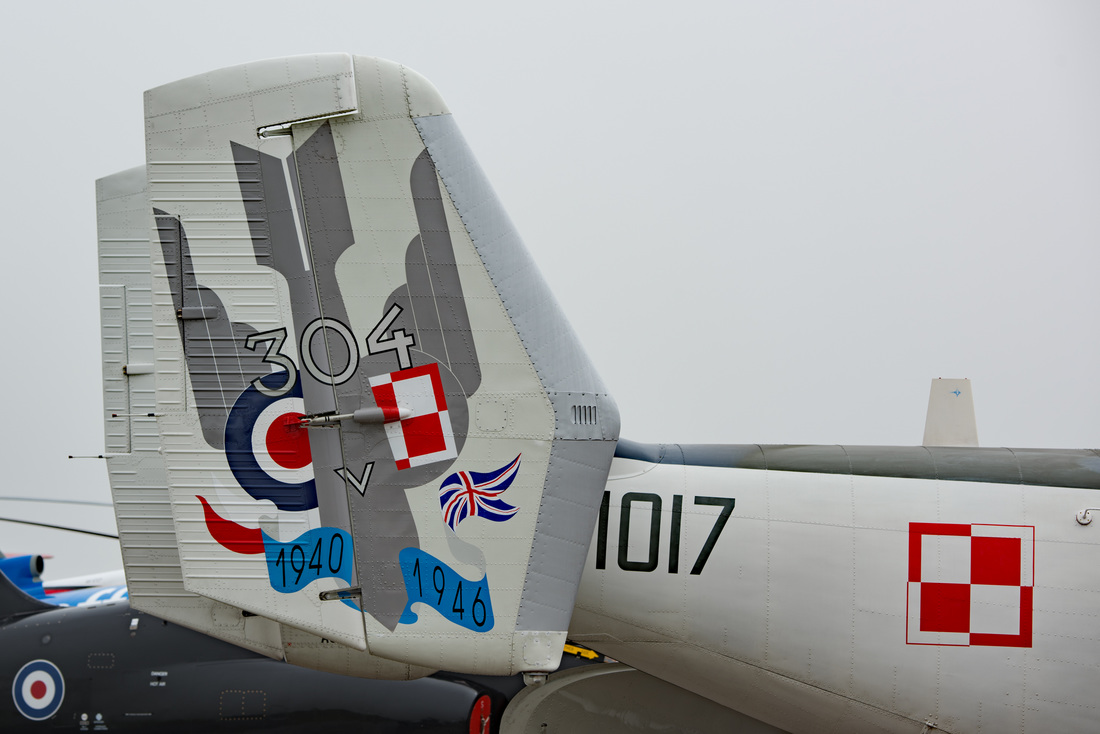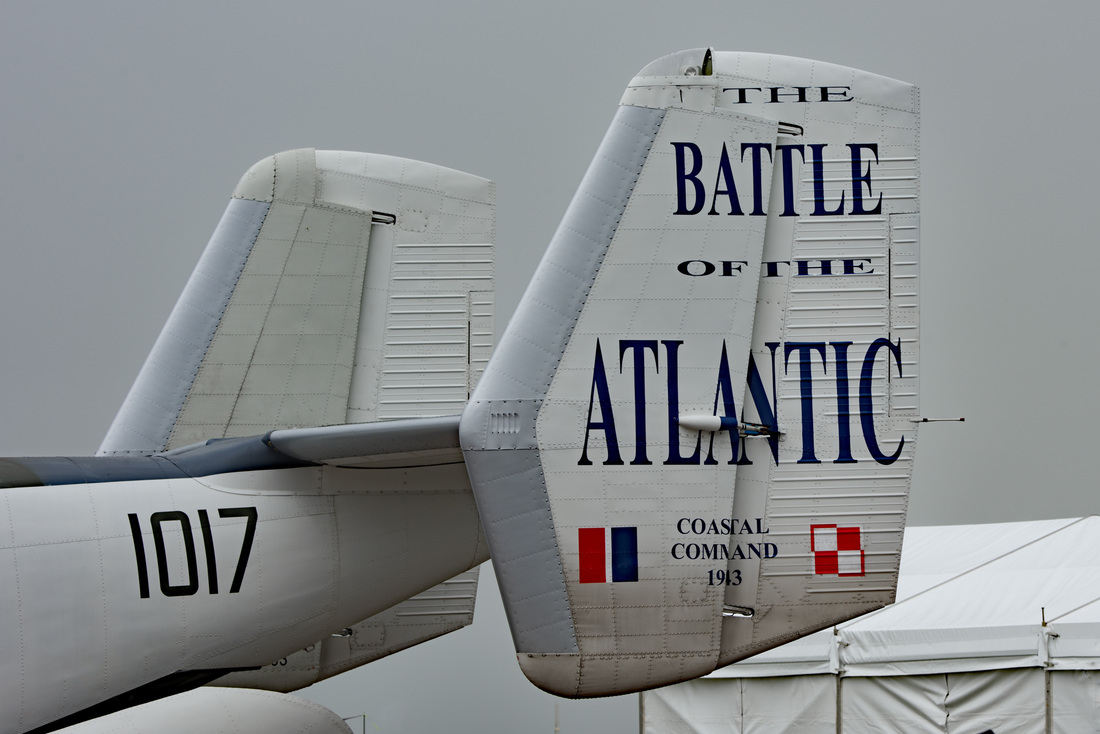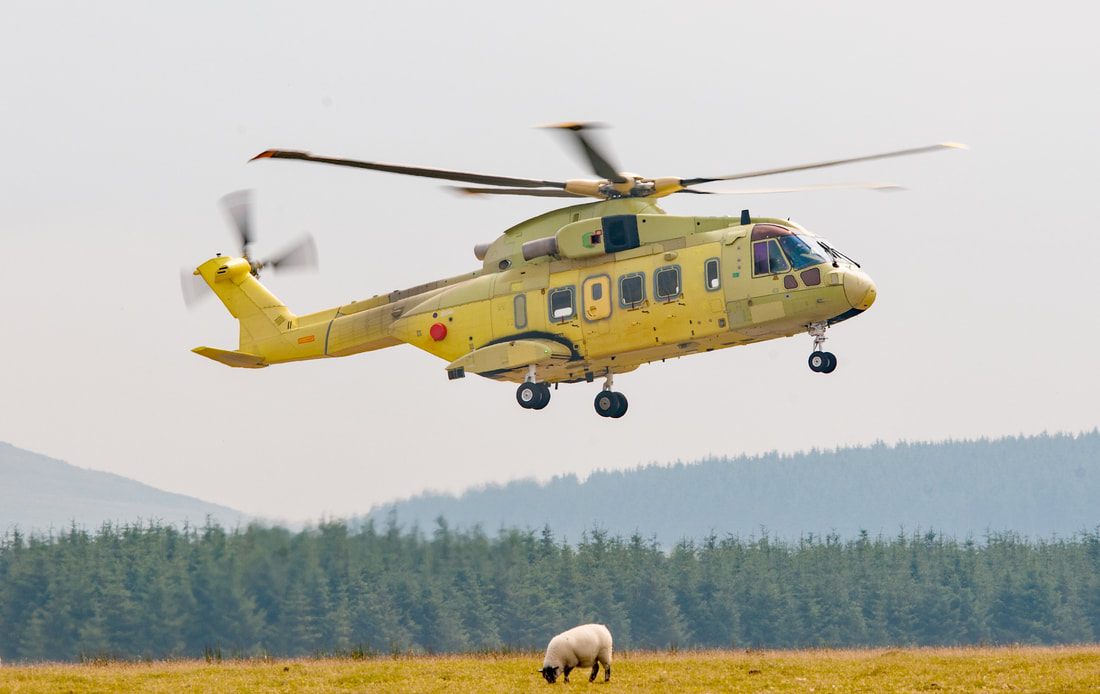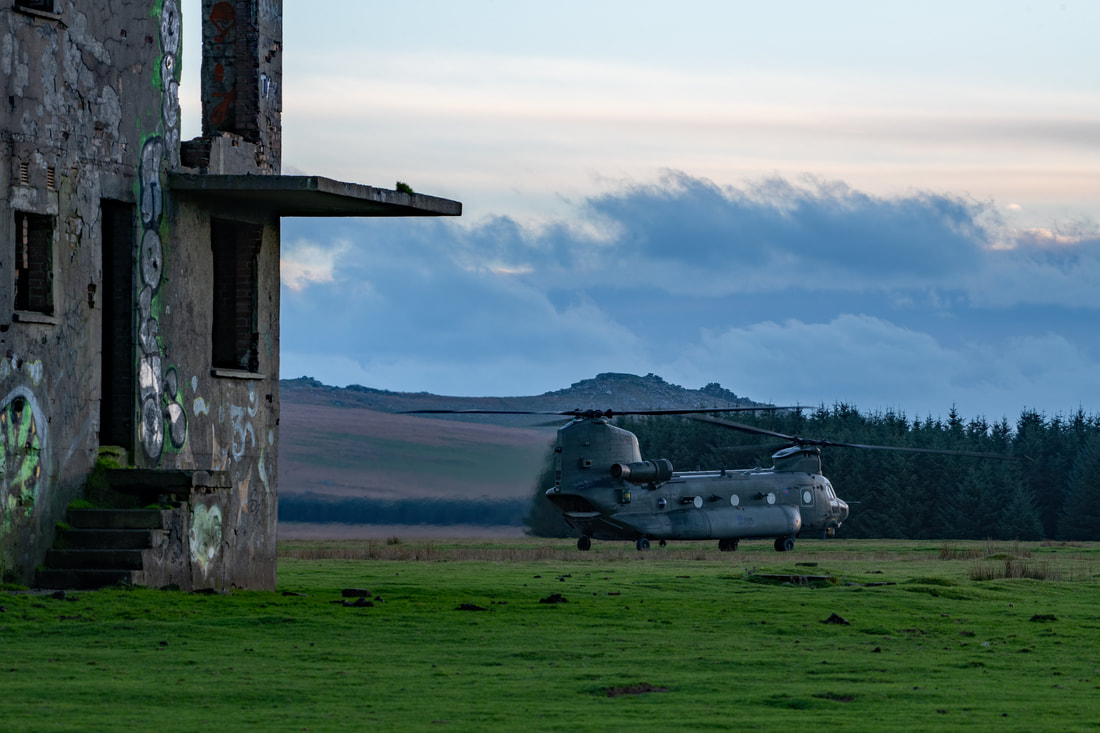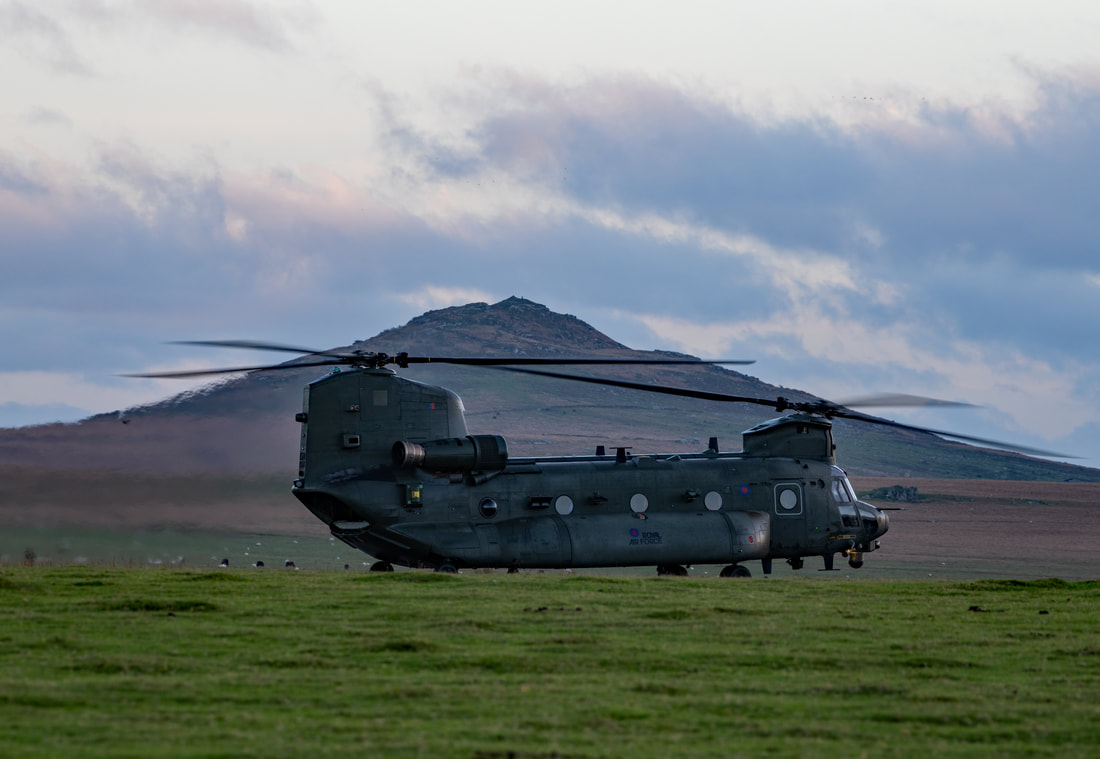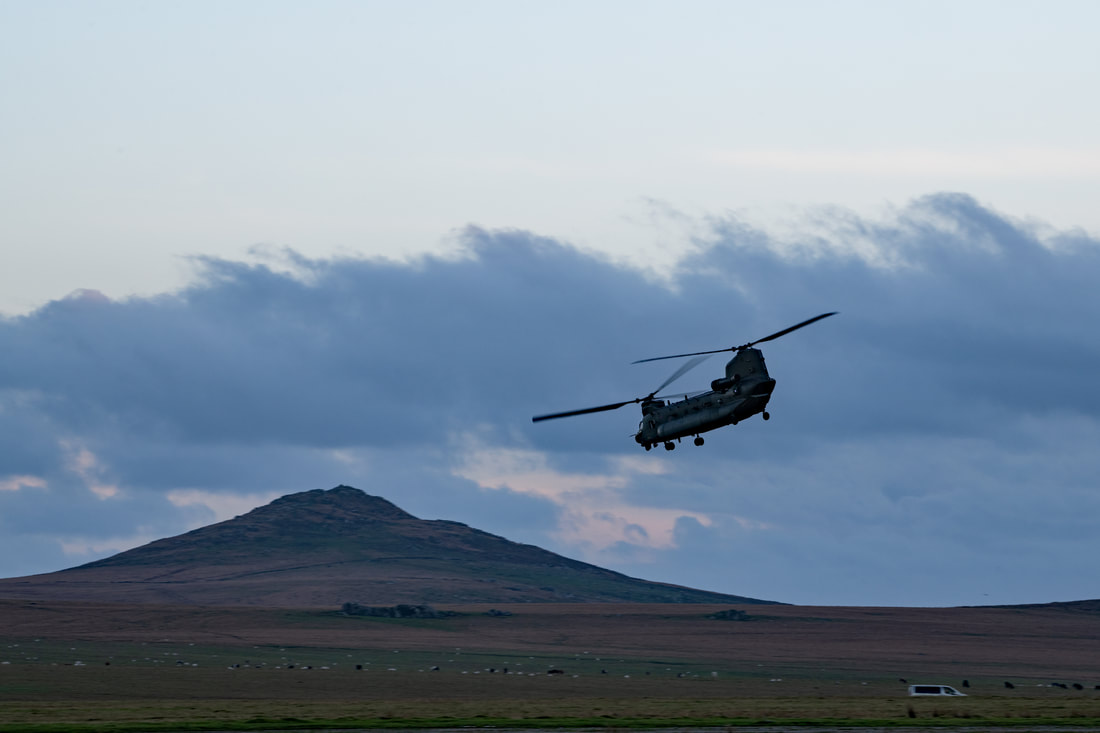RAF Davidstow Moor
History
Airfield Code Letters - DD
Bodmin Moor is an area of bleak, windswept moorland that forms the highest part of Cornwall. Lower than its eastern neighbour Dartmoor, it reaches the lofty height of 420m (1378’) at the granite summit of Bronn Wennili (Hill of Swallows). As you look to the west with the second-highest Cornish peak Roughtor (400m) on your left, an area of reasonably level ground is where the former airfield of RAF Davidstow Moor is located. At 294 metres (970’), it is the highest airfield in Britain. This made the site very susceptible to hill fog, sea mists, and low cloud, all of which are not good if you happen to be flying aircraft.
It was estimated in 1943 for 80% of the time, weather conditions at Davidstow were unsuitable for flying. Place the highest point in Cornwall, Bronn Wennili, next to it, and the problem is further compounded. Davidstow Moor could be a very inhospitable environment, but it could also be a delightful place to be, especially on a summers day with the beautiful views out over Bodmin Moor and a distant Dartmoor.
The airfield was opened on 1 October 1942 with Sqn Ldr C F Edwards as commanding officer and was allocated to 19 Group Coastal Command. This was a pivotal time when the outcome of the Battle of the Atlantic was hanging in the balance. Three runways were constructed as one main at 2,000ft and two subsidiaries at 1,400ft. Fifty panhandle dispersals were completed off the southern and western perimeter tracks. Accommodation at the time of opening was still under construction, and the lack of a permanent water supply must have made life a little difficult for those posted to the field. Three T2 hangars were provided to give a degree of cover for aircraft maintenance/damage repair in what was quite a harsh exposed environment when bad weather rolled in off the Atlantic Ocean.
The first record of aerial use of the airfield came on 11 October 1942 with the Operations Record Book stating 5 aircraft landed and later took off. It omits to say what type of machine these were. The following day a convoy of 98 vehicles arrived at the site carrying 6 officers and 193 other ranks of the USAAF, along with bomb and ammunition stores. This was followed on 15 October by the first identified landing at the airfield, when a Douglas C-47 from Hendon brought in 18 army personnel to perform guard duties.
The first operational aircraft to arrive at Davidstow flew in on 8 November 1942, 18 B-24Ds Liberators of the 44th (The Flying Eight-Balls) and 93rd Bombardment Groups landed from their bases at Shipham and Alconbury, respectively. The Liberators caused a bit of apprehension to the locals who thought the aircraft might be German. The units were fuelled and bombed up, ready to fly the next day in an attack on the U-Boat pens at St Nazaire. The mission was in support of Operation Torch, which was the allied invasion of French North Africa. Fourteen aircraft carried out the raid, with the 93rd bombing at 14.02 hrs and the 44th at 14.08 hrs. The bombers returned to Davidstow, having achieved varying degrees of success with damage inflicted to one B-24 from the 93rd during the raid. The B-24s returned to their home bases on 9 November 1942. Similar missions were flown later in the month using Boeing B-17Fs of the 306th Bomb Group who flew in from Thurleigh.
Bodmin Moor is an area of bleak, windswept moorland that forms the highest part of Cornwall. Lower than its eastern neighbour Dartmoor, it reaches the lofty height of 420m (1378’) at the granite summit of Bronn Wennili (Hill of Swallows). As you look to the west with the second-highest Cornish peak Roughtor (400m) on your left, an area of reasonably level ground is where the former airfield of RAF Davidstow Moor is located. At 294 metres (970’), it is the highest airfield in Britain. This made the site very susceptible to hill fog, sea mists, and low cloud, all of which are not good if you happen to be flying aircraft.
It was estimated in 1943 for 80% of the time, weather conditions at Davidstow were unsuitable for flying. Place the highest point in Cornwall, Bronn Wennili, next to it, and the problem is further compounded. Davidstow Moor could be a very inhospitable environment, but it could also be a delightful place to be, especially on a summers day with the beautiful views out over Bodmin Moor and a distant Dartmoor.
The airfield was opened on 1 October 1942 with Sqn Ldr C F Edwards as commanding officer and was allocated to 19 Group Coastal Command. This was a pivotal time when the outcome of the Battle of the Atlantic was hanging in the balance. Three runways were constructed as one main at 2,000ft and two subsidiaries at 1,400ft. Fifty panhandle dispersals were completed off the southern and western perimeter tracks. Accommodation at the time of opening was still under construction, and the lack of a permanent water supply must have made life a little difficult for those posted to the field. Three T2 hangars were provided to give a degree of cover for aircraft maintenance/damage repair in what was quite a harsh exposed environment when bad weather rolled in off the Atlantic Ocean.
The first record of aerial use of the airfield came on 11 October 1942 with the Operations Record Book stating 5 aircraft landed and later took off. It omits to say what type of machine these were. The following day a convoy of 98 vehicles arrived at the site carrying 6 officers and 193 other ranks of the USAAF, along with bomb and ammunition stores. This was followed on 15 October by the first identified landing at the airfield, when a Douglas C-47 from Hendon brought in 18 army personnel to perform guard duties.
The first operational aircraft to arrive at Davidstow flew in on 8 November 1942, 18 B-24Ds Liberators of the 44th (The Flying Eight-Balls) and 93rd Bombardment Groups landed from their bases at Shipham and Alconbury, respectively. The Liberators caused a bit of apprehension to the locals who thought the aircraft might be German. The units were fuelled and bombed up, ready to fly the next day in an attack on the U-Boat pens at St Nazaire. The mission was in support of Operation Torch, which was the allied invasion of French North Africa. Fourteen aircraft carried out the raid, with the 93rd bombing at 14.02 hrs and the 44th at 14.08 hrs. The bombers returned to Davidstow, having achieved varying degrees of success with damage inflicted to one B-24 from the 93rd during the raid. The B-24s returned to their home bases on 9 November 1942. Similar missions were flown later in the month using Boeing B-17Fs of the 306th Bomb Group who flew in from Thurleigh.
|
One aircraft that was later to achieve celebrity status in a film made by William Wyler was Memphis Belle. The aircraft was a Boeing B-17F Flying Fortress with a tail number of 41-24485 and flew with the 324th Bombardment Squadron of the 91st Bomb Group. Memphis Belle was the first 8th Air Force bomber to be officially recognised as achieving 25 missions. On 17 November 1942, Memphis Belle flew on a mission to bomb the submarine pens at St Nazaire. This was to be the aircraft's third operation, and the 324th's log for the day shows that Memphis Belle landed at Davidstow Moor with the rest of the squadron due to poor weather at Bassingbourn.
|
The aircraft was captained on this day by Robert K Morgan, and anyone who has seen Wyler's film will recognise the name and the man. The B-17 survives today at The National Museum Of The United States Air Force at Wright Patterson AFB.
On the last day of December 1942, eight Bell P-400 Airacobra of the 360th Fighter Group used the airfield on their way to North Africa. These mid-engine fighters would have been quite a rarity to Cornwall at the time and in the UK, for that matter.
On the last day of December 1942, eight Bell P-400 Airacobra of the 360th Fighter Group used the airfield on their way to North Africa. These mid-engine fighters would have been quite a rarity to Cornwall at the time and in the UK, for that matter.
The first six months of 1943 saw various squadrons operating from Davidstow. These included Lockheed Hudsons of 53 and 279, and 612, flying Armstrong Whitworth Whitley MK.VIIs (later Wellington MK.X). A significant operation for 279 Squadron took place on 17 February 1943 when one of their Hudsons undertook the first drop of an airborne lifeboat. Dropped on parachutes, the lifeboat carried equipment and the supplies needed for a downed aircrew to survive until help arrived to affect a rescue.
On 1 June 1943, an aircraft from Davidstow carried out a fruitless search for a Douglas Dakota shot down in the Bay of Biscay by Luftwaffe Junkers Ju88s. The aircraft had been on a regular flight from Lisbon to Bristol and this day had been carrying the actor Leslie Howard, who had starred in the 1942 film First of the Few, the story of R.J. Mitchell and the Spitfire.
None of the aforementioned squadrons stayed for long at Davidstow and soon went to other duties and destinations. 53 left for RAF Docking in February 1943, 612 departed to RAF Chivenor in May 1943 (although a detachment stayed at Davidstow until November 1943), and 279 relocated to RAF Harrowbeer in June 1943.
On 1 June 1943, an aircraft from Davidstow carried out a fruitless search for a Douglas Dakota shot down in the Bay of Biscay by Luftwaffe Junkers Ju88s. The aircraft had been on a regular flight from Lisbon to Bristol and this day had been carrying the actor Leslie Howard, who had starred in the 1942 film First of the Few, the story of R.J. Mitchell and the Spitfire.
None of the aforementioned squadrons stayed for long at Davidstow and soon went to other duties and destinations. 53 left for RAF Docking in February 1943, 612 departed to RAF Chivenor in May 1943 (although a detachment stayed at Davidstow until November 1943), and 279 relocated to RAF Harrowbeer in June 1943.
|
As always, in wartime, as in peace, there are losses of aircraft and crews. On 6 May 1943, AW Whitley VII EB328 of 612 Squadron was flying from Davidstow when the machine crashed near Wadebridge with the loss of five crew, the station ORB states Sgt Edge baled out.
The crew on this day flying EB328 were: Sgt Kenneth Steels - Age 22 Fg Off Charles Harry Norton - Age 22 Sgt Reginald Arthur Frost - Age 20 Sgt Cyril William Waterer - Age 22 Fg Off Douglas James Webb - Age 20 While four members of the crew have been interred in churchyards in other parts of the UK, Fg Off Norton was buried at The Church of St David, Davidstow, close to the airfield from where he took his last flight. |
The next major event took place on 16 May, with the 8th Air Force returning with 45 Liberators of the 44th and 93rd Bomb Groups. The following day, 40 aircraft attacked Bordeaux, where opposition was light with damage witnessed to the lock gates and the Matford Aero Engine works.
In June 1943, full control was taken of Davidstow by 19 Group, 304 (Polish) Squadron (previously flying with Bomber Command) moved in along with 547 Squadron both units flying Wellingtons, their mission was to seek out and destroy submarines in the Bay of Biscay. At this time, the U-Boats changed their tactics and instead of diving when aircraft approached, they chose to fight it out with their tormentors on the surface. This made life far more difficult for the attacking aircraft and crews, success was limited, but the attacks continued later on with the use of the Leigh Light, which was used at night to illuminate surfaced U-Boats. Inevitably there were casualties while undertaking this type of operation, with 304 Squadron losing three of its Wellington in July 1943. One aircraft crashed on take-off, killing the pilot and navigator, although four other crew members survived. Two further aircraft were lost by 304 the following month, along with 547 Squadron, where several aircraft fell to the guns of Luftwaffe Junkers Ju88s, which were now on regular patrol in the Bay of Biscay area. Joining the Wellingtons for a brief period in July were three Consolidated B-24D Liberator Vs of 59 Squadron on detachment from Aldergrove. This trio of large four-engine bombers was tasked to carry out long hours of convoy patrols, where on occasion, U-Boats were sighted and attacked.
Davidstow, due to its position, was always subject to the vagaries of the Cornish weather. Frequently obscured by sea mists, fog or low clouds, operations were often hampered. In an attempt to overcome this frequent situation, it was decided to use a rudimentary type of ground-controlled approach radar at the airfield. The equipment was installed and trialled in August 1943, but, ironically, the poor weather prevented it from being calibrated correctly. It was therefore removed and sent to RAF St Eval further down the Cornish coast near Padstow. So Davidstow was still, due to its location, subject to the weather and all that entailed with undertaking flying operations.
In October four, Wellington X and a single Halifax III of 192 Squadron detached from Feltwell's airfield. The unit's operations were somewhat secretive as they flew ELINT missions out into the Bay of Biscay as far as the north coast of Spain. The aircraft was equipped to gather information, location, volume and direction of German radio signals and radar patterns that were tracking Coastal Commands anti-submarine patrols in the Bay. 192 Squadron flew from Davidstow until mid-May 1944 and carried out on average 50 sorties a month, losing three aircraft in the process. One of the squadron's missions was to interrupt the German's supply of ball bearings. Luftwaffe Focke-Wulf Fw200 Condors were tasked to fly these cargos from Sweden down to Spain and Portugal. The aircraft would then proceed up the Bay of Biscay and home onto a beam for navigation purposes. 192's role was to 'bend' this beam so that the Condors would fly off out into the Atlantic and run out of fuel halfway to America.
No 547 Squadron departed the airfield in October 1943 for RAF Thorney Island in Hampshire, with 304 Squadron leaving for RAF Predannack in December. As 304 Squadron left, 280 Squadron flying Warwicks arrived. Search and Rescue (SAR) was now, for the time being, the primary purpose of Davidstow. 280 Squadron's Warwicks were joined by 269 Squadron in January 1944 and converted to the SAR role. 269 used various aircraft, including Lockheed Hudson II, III and Vickers Supermarine Walrus IIs. In March 1944, the squadron moved out of Davidstow to take up residence in the Azores. For a brief period in March 1944, Boeing Flying Fortress IIAs of 206 Squadron used the airfield before moving to RAF St Eval, where the crews converted to Liberators.
In April 1944, 524 Squadron reformed at Davidstow with Wellington XIVs. Subsequently, 524 absorbed 415 Squadron, which resulted in 16 aircraft on strength. Following on, the Wick Strike Wing relocated to Davidstow to undertake operations before D-Day. The Wing consisted of 144 and 404 Squadrons flying Bristol Beaufighter X multi-role aircraft. On 12 May, 144, 404 and 524 joined up to become 154 (GR) Wing.
In June 1943, full control was taken of Davidstow by 19 Group, 304 (Polish) Squadron (previously flying with Bomber Command) moved in along with 547 Squadron both units flying Wellingtons, their mission was to seek out and destroy submarines in the Bay of Biscay. At this time, the U-Boats changed their tactics and instead of diving when aircraft approached, they chose to fight it out with their tormentors on the surface. This made life far more difficult for the attacking aircraft and crews, success was limited, but the attacks continued later on with the use of the Leigh Light, which was used at night to illuminate surfaced U-Boats. Inevitably there were casualties while undertaking this type of operation, with 304 Squadron losing three of its Wellington in July 1943. One aircraft crashed on take-off, killing the pilot and navigator, although four other crew members survived. Two further aircraft were lost by 304 the following month, along with 547 Squadron, where several aircraft fell to the guns of Luftwaffe Junkers Ju88s, which were now on regular patrol in the Bay of Biscay area. Joining the Wellingtons for a brief period in July were three Consolidated B-24D Liberator Vs of 59 Squadron on detachment from Aldergrove. This trio of large four-engine bombers was tasked to carry out long hours of convoy patrols, where on occasion, U-Boats were sighted and attacked.
Davidstow, due to its position, was always subject to the vagaries of the Cornish weather. Frequently obscured by sea mists, fog or low clouds, operations were often hampered. In an attempt to overcome this frequent situation, it was decided to use a rudimentary type of ground-controlled approach radar at the airfield. The equipment was installed and trialled in August 1943, but, ironically, the poor weather prevented it from being calibrated correctly. It was therefore removed and sent to RAF St Eval further down the Cornish coast near Padstow. So Davidstow was still, due to its location, subject to the weather and all that entailed with undertaking flying operations.
In October four, Wellington X and a single Halifax III of 192 Squadron detached from Feltwell's airfield. The unit's operations were somewhat secretive as they flew ELINT missions out into the Bay of Biscay as far as the north coast of Spain. The aircraft was equipped to gather information, location, volume and direction of German radio signals and radar patterns that were tracking Coastal Commands anti-submarine patrols in the Bay. 192 Squadron flew from Davidstow until mid-May 1944 and carried out on average 50 sorties a month, losing three aircraft in the process. One of the squadron's missions was to interrupt the German's supply of ball bearings. Luftwaffe Focke-Wulf Fw200 Condors were tasked to fly these cargos from Sweden down to Spain and Portugal. The aircraft would then proceed up the Bay of Biscay and home onto a beam for navigation purposes. 192's role was to 'bend' this beam so that the Condors would fly off out into the Atlantic and run out of fuel halfway to America.
No 547 Squadron departed the airfield in October 1943 for RAF Thorney Island in Hampshire, with 304 Squadron leaving for RAF Predannack in December. As 304 Squadron left, 280 Squadron flying Warwicks arrived. Search and Rescue (SAR) was now, for the time being, the primary purpose of Davidstow. 280 Squadron's Warwicks were joined by 269 Squadron in January 1944 and converted to the SAR role. 269 used various aircraft, including Lockheed Hudson II, III and Vickers Supermarine Walrus IIs. In March 1944, the squadron moved out of Davidstow to take up residence in the Azores. For a brief period in March 1944, Boeing Flying Fortress IIAs of 206 Squadron used the airfield before moving to RAF St Eval, where the crews converted to Liberators.
In April 1944, 524 Squadron reformed at Davidstow with Wellington XIVs. Subsequently, 524 absorbed 415 Squadron, which resulted in 16 aircraft on strength. Following on, the Wick Strike Wing relocated to Davidstow to undertake operations before D-Day. The Wing consisted of 144 and 404 Squadrons flying Bristol Beaufighter X multi-role aircraft. On 12 May, 144, 404 and 524 joined up to become 154 (GR) Wing.
|
Two 1,770hp Bristol Hercules engines powered the Beaufighter X, and it could fly at over 300 mph at sea level with a range of 1,470 miles. A fearsome forward-firing armament consisted of four 20mm cannons.
The aircraft could also carry a 1,650 or 2,127Ib torpedo, eight rocket projectiles and two 250Ib bombs under the wing. A single .303 machine gun was provided in the rear for self-defence. To aid the location of ships at sea, an Air to Surface Vessel (ASV) radar was carried in the aircraft's nose. |
The commander of 404 Squadron was Wg Cdr A K 'Ken' Gatward DSO, DFC Bar, Wg Cdr O F Lumsden headed up 144 Squadron, both men were highly experienced airmen and operational flyers. On 12 June 1942, Gatward and his navigator, Sergeant George Fern, had flown a Beaufighter on a solo mission from RAF Thorney Island to the centre of Paris, where a French Tricolour was dropped over the Arc de Triomphe with another being dropped over the German Kriegsmarine HQ. Gatward strafed the HQ with 20mm cannon fire to make his point to add a little more insult to events.
Poor weather at Davidstow often curtailed operations, so it was not until 19 May 1944 that conditions had improved enough for the first mission for the Strike Wing to take place. Twenty-two Beaufighters escorted by twenty-eight Spitfires attacked two torpedo boats and four escort vessels near Brest. The attack was led by Gatward commanding 404 Squadron, their Beaufighters armed with cannon and 60Ib rocket projectiles, anti flak escort was provided by 144 Squadron armed with cannon only. The attack results were somewhat disappointing, but the flotilla did have to put into Brest for repairs. The Beaufighter flown by Sqn Ldr P W Dunn of 144 Squadron was shot down, and a number of others were damaged. Plt Off Reid was hit in the left forearm by a cannon shell which necessitated a forced landing of his Beaufighter at RAF Harrowbeer. Claims of hits by the crews of 404 Squadron on the ships with rocket projectiles were later shown by German records to be inaccurate, as all missed their intended targets. The probable cause of this could have been due to pilots being put off their aim by the massive weight of return fire, with several aircraft hit with one forced to land at RAF Predannack with wing damage.
During the afternoon of D-Day, three German destroyers were spotted by a PRU leaving Bordeaux. The vessels aim was to intercept Allied invasion shipping. 144 and 404 Squadrons were launched to attack, and in the company of eight Mosquitos of 248 Squadron from Portreath, the operation resulted in the three destroyers sunk. Several Beaufighters were badly damaged, with one force landing at Predannack and another ditching. Proving that the SAR operation was effective, a Warwick dropped a lifeboat to the downed Beaufighter crew, who were picked up by destroyer two days later. On 30 June, 404, along with 235 and 248 Squadrons flying Mosquitos, shared in the destruction of the submarine chaser UJ1408 in the Bay of Biscay. This ended the operations for the month.
Following on from this activity, on 1 July, 154 (GR) Wing moved to RAF Strubby in Lincolnshire. However, 404 left a number of aircraft at the airfield to continue attacks on Kriegsmarine shipping off the coasts of western France. On 6 August, 236 Squadron arrived at Davidstow from RAF North Coates to join 404, the purpose of the two squadrons was to take part in shipping strikes against the German Navy. The Beaufighters used 25Ib 'J' type rocket projectiles to devastating effect. Between 6 and 26 August, the squadrons destroyed or damaged minesweepers, a floating dock, armed trawlers and destroyers.
The final mission by the Davidstow Beaufighters took place on 24 August. Twenty aircraft led by Sqn Ldr Tacon attacked a destroyer and a torpedo boat in the port of Le Harve. Three Beaufighters were lost on this operation, so it just shows that the German flak defences were still as effective as ever. Luckily the crews of the downed aircraft all survived.
After all this activity, Davidstow fell into relative quiet, and the airfield was placed in Care and Maintenance on 20 September 1944. The RAF Regiment had been in residence since July 1944 and their numbers built up over the coming months. The camp started to run down in 1945, and by October of the same year, the Regiment had left. In December 1945, Davidstow finally closed.
After closure, Davidstow became for a short time one of the first Formula 1 racing circuits. Once again, the weather played a hand in making the site too dangerous to race due to poor visibility.
Dairy Crest has a creamery built on part of the old site, and it is from here they make their very popular (with me anyway) Davidstow cheese.
Poor weather at Davidstow often curtailed operations, so it was not until 19 May 1944 that conditions had improved enough for the first mission for the Strike Wing to take place. Twenty-two Beaufighters escorted by twenty-eight Spitfires attacked two torpedo boats and four escort vessels near Brest. The attack was led by Gatward commanding 404 Squadron, their Beaufighters armed with cannon and 60Ib rocket projectiles, anti flak escort was provided by 144 Squadron armed with cannon only. The attack results were somewhat disappointing, but the flotilla did have to put into Brest for repairs. The Beaufighter flown by Sqn Ldr P W Dunn of 144 Squadron was shot down, and a number of others were damaged. Plt Off Reid was hit in the left forearm by a cannon shell which necessitated a forced landing of his Beaufighter at RAF Harrowbeer. Claims of hits by the crews of 404 Squadron on the ships with rocket projectiles were later shown by German records to be inaccurate, as all missed their intended targets. The probable cause of this could have been due to pilots being put off their aim by the massive weight of return fire, with several aircraft hit with one forced to land at RAF Predannack with wing damage.
During the afternoon of D-Day, three German destroyers were spotted by a PRU leaving Bordeaux. The vessels aim was to intercept Allied invasion shipping. 144 and 404 Squadrons were launched to attack, and in the company of eight Mosquitos of 248 Squadron from Portreath, the operation resulted in the three destroyers sunk. Several Beaufighters were badly damaged, with one force landing at Predannack and another ditching. Proving that the SAR operation was effective, a Warwick dropped a lifeboat to the downed Beaufighter crew, who were picked up by destroyer two days later. On 30 June, 404, along with 235 and 248 Squadrons flying Mosquitos, shared in the destruction of the submarine chaser UJ1408 in the Bay of Biscay. This ended the operations for the month.
Following on from this activity, on 1 July, 154 (GR) Wing moved to RAF Strubby in Lincolnshire. However, 404 left a number of aircraft at the airfield to continue attacks on Kriegsmarine shipping off the coasts of western France. On 6 August, 236 Squadron arrived at Davidstow from RAF North Coates to join 404, the purpose of the two squadrons was to take part in shipping strikes against the German Navy. The Beaufighters used 25Ib 'J' type rocket projectiles to devastating effect. Between 6 and 26 August, the squadrons destroyed or damaged minesweepers, a floating dock, armed trawlers and destroyers.
The final mission by the Davidstow Beaufighters took place on 24 August. Twenty aircraft led by Sqn Ldr Tacon attacked a destroyer and a torpedo boat in the port of Le Harve. Three Beaufighters were lost on this operation, so it just shows that the German flak defences were still as effective as ever. Luckily the crews of the downed aircraft all survived.
After all this activity, Davidstow fell into relative quiet, and the airfield was placed in Care and Maintenance on 20 September 1944. The RAF Regiment had been in residence since July 1944 and their numbers built up over the coming months. The camp started to run down in 1945, and by October of the same year, the Regiment had left. In December 1945, Davidstow finally closed.
After closure, Davidstow became for a short time one of the first Formula 1 racing circuits. Once again, the weather played a hand in making the site too dangerous to race due to poor visibility.
Dairy Crest has a creamery built on part of the old site, and it is from here they make their very popular (with me anyway) Davidstow cheese.
304 (Silesia) Squadron
304 (Silesia) Squadron was formed in July 1940 with mostly Polish aircrews who had escaped from their native country to Great Britain to continue the fight against the Nazis following the Fall of France. Initially assigned to Bomber Command, the unit transferred to Coastal Command in May 1942. Their purpose now was to undertake maritime patrols to seek out and attack German E and U Boats that were wreaking havoc among the Allies convoys.
At the time, 304 Squadron were flying Vickers Wellington bombers, and in June 1943, the squadron moved to the 19 Group airfield of RAF Davidstow Moor, located high on Bodmin Moor in North Cornwall. From here, the unit undertook long and arduous patrols out over the Bay of Biscay to conduct anti-submarine warfare. Not only was the weather often against them, but they would also ran the risk of interception by Luftwaffe long-range fighters, and a number of Wellingtons were shot down.
The Squadron relocated to RAF Predannack in February 1944, and their endeavours while at Davidstow are commemorated in the Davidstow Moor RAF Memorial Museum.
Today the Polish Naval Aviation Brigade from 44 Baza Lotnictwa Morskeigo - Siemerowice (44 BlotM) flies PZL M28B 1R Bryza aircraft to undertake maritime surveillance, a role that their forefathers in 304 Squadron would have been very familiar.
In remembrance of their former comrade's deeds, one of 44 BlotM's Bryza aircraft, serial 1017, has had special tail art applied that depicts 304 Squadron's Winged Bomb Badge. The aircraft is often seen at UK airshows. The art application is a very fitting reminder and thought-provoking nod to their countryman's struggle against tyranny all those decades ago.
The Squadron relocated to RAF Predannack in February 1944, and their endeavours while at Davidstow are commemorated in the Davidstow Moor RAF Memorial Museum.
Today the Polish Naval Aviation Brigade from 44 Baza Lotnictwa Morskeigo - Siemerowice (44 BlotM) flies PZL M28B 1R Bryza aircraft to undertake maritime surveillance, a role that their forefathers in 304 Squadron would have been very familiar.
In remembrance of their former comrade's deeds, one of 44 BlotM's Bryza aircraft, serial 1017, has had special tail art applied that depicts 304 Squadron's Winged Bomb Badge. The aircraft is often seen at UK airshows. The art application is a very fitting reminder and thought-provoking nod to their countryman's struggle against tyranny all those decades ago.
Today's Visitors
RAF and Navy helicopters do put in occasional appearances at Davidstow and Westland's have test flown their Merlins at the airfield. One was noted on 26 July 2012, quite close to the Watch Office.
RAF and Navy helicopters do put in occasional appearances at Davidstow and Westland's have test flown their Merlins at the airfield. One was noted on 26 July 2012, quite close to the Watch Office.
Boeing Chinook HC.6 ZH899 visiting Davidstow Moor 14 November 2022
Sources -
Memories and Records of RAF Davidstow Moor - David Keast
Action Stations 5: Military Airfields of the South-West - Chris Ashworth
Devon and Cornwall Airfields in the Second World War = Graham Smith
Bomber Command - Reflections Of War Volume 3 - Martin W Bowman
Mighty Eighth War Diary - Roger A Freeman
The Strike Wings Special Anti-Shipping Squadrons 1942-45 - Roy Conyers Nesbit - HMSO
Memphis Belle - Dispelling The Myths - Graham Simons & Harry Friedman
raf.web
Return To RAF Davidstow Moor Home Page
Memories and Records of RAF Davidstow Moor - David Keast
Action Stations 5: Military Airfields of the South-West - Chris Ashworth
Devon and Cornwall Airfields in the Second World War = Graham Smith
Bomber Command - Reflections Of War Volume 3 - Martin W Bowman
Mighty Eighth War Diary - Roger A Freeman
The Strike Wings Special Anti-Shipping Squadrons 1942-45 - Roy Conyers Nesbit - HMSO
Memphis Belle - Dispelling The Myths - Graham Simons & Harry Friedman
raf.web
Return To RAF Davidstow Moor Home Page
